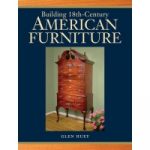We may receive a commission when you use our affiliate links. However, this does not impact our recommendations.
Just got home from the Woodworking in America Midwest, the second of two conferences held this fall. Just want to say thanks to all of you who attended and supported these conferences. I really enjoyed meeting folks and appreciated the opportunity I was given to do so. Thanks also to F&W pubs and Popular Woodworking Magazine. I’m very grateful.
Like my magazine articles, my talks this year intended to convey an understanding beyond the information contained in them. I gave three talks, 18th-century Tricks of the Trade, 18th-century Stock Preparation, and Moldings with Hollows and Rounds. Here’s a brief run down of each:
18th-century Tricks of the Trade attempted to paint a picture of 18th-century woodworking attitudes to draw the distinction between modern hand tool woodwork and period work. Period craftsmen worked with a fairly restricted palette of easy-to-work woods. Their tools were highly optimized, but sometimes the details that contributed to their performance can be overlooked. Lastly, period craftsmen were men of their time. They drank on the job and used urine as an ingredient in some finishes. Not all of their highly optimized shop practices are appropriate for modern workers.
18th-century Stock Preparation included primary sources detailing how and from where cabinetmakers purchased their stock, and how it differed and did not differ from our stock. The idea was to establish some contextual relationship between joinery and the stock that was used. We looked at account book and price book data to determine how much time craftsmen had to build furniture (not much). We also looked at surfaces – even in the best instances, period surfaces were probably not up to our standards. And period planes probably couldn’t perform to our expectations. Cherry picking 18th-century tools, or techniques and applying them to modern materials probably isn’t a recipe for success.
Moldings with Hollows and Rounds was my favorite talk and the presentation I spent the most time preparing. My take is that using the planes is fairly easy. The trick to using H&R really lies in precisely how to incorporate moldings into your projects aesthetically. And in my mind, that’s the big advantage in H&R. They let us choose the size and the shape. Silly (in my mind) to use H&R to make shapes you can more easily cut with a router. I tried to make the case for classical moldings and traced a specific profile from ancient Rome to medieval England to 18th-century Philadelphia. Once in Philly, we looked at the documents that guided the selection of profiles, to the per-foot prices of those moldings, to the account book entries billing the customer for the work, to the actual work itself. Then I duplicated the profiles (with admittedly mixed success). The idea here was to explore the notion of using historical data to influence contemporary work. This defines my vision of period woodworking. It’s not just about puffy shirts and tools. In fact, the puffy shirt is the result of the vision, not the vision itself (if that makes sense).
Each talk attempted to help paint a picture of period woodworking as I see it and practice it; understanding the attitudes of the people at the time, seeing the contextual relationships between their products, tools, and techniques (remove one leg of this three legged stool….), and lastly the use of historical data to help us understand the goals, entrance and exit criteria, and inevitably work of period craftsmen.
Thanks PW, F+W, and all of you who attended.
– Adam Cherubini
 For more on period woodworking, check out “Building 18th-century American Furniture,” by Glen Huey.
For more on period woodworking, check out “Building 18th-century American Furniture,” by Glen Huey.
Here are some supplies and tools we find essential in our everyday work around the shop. We may receive a commission from sales referred by our links; however, we have carefully selected these products for their usefulness and quality.










Adam, I was a first timer this year. I was able to attend all three of your sessions and found you and your information well worth the price of admission. You demonstrate a true passion for what you do. As an 18th century reenactor I understand how difficult it can be to look at things through the eyes of people long dead, and leave modern attitudes behind. I got just what I was looking for. Thank You!
Hey Adam – are you perchance missing a steel planing stop that drops into a 3/4 dog hole? I like it. A lot. But I’ll send it to you…
Really wish I could have attended. Your methods are right up my alley as to how I attempt to work wood. Any chance you’ll be teaching any classes in the mid-atlantic area in the near future, either on your own or through a woodworking school. I’d love to get you to do a talk at one of our Chesapeake Chapter SAPFM meetings some day.
So sorry to have missed it. PWM would clean up if they offered video of selected talks to those of us who couldn’t make WIA.
So sorry to have missed it. PW would clean up if they offered video of selected talks to those of us who couldn’t make WIA.
I attended one of your talks in Pasadena…I was informed, educated, and entertained. I learned new things. Thanks!